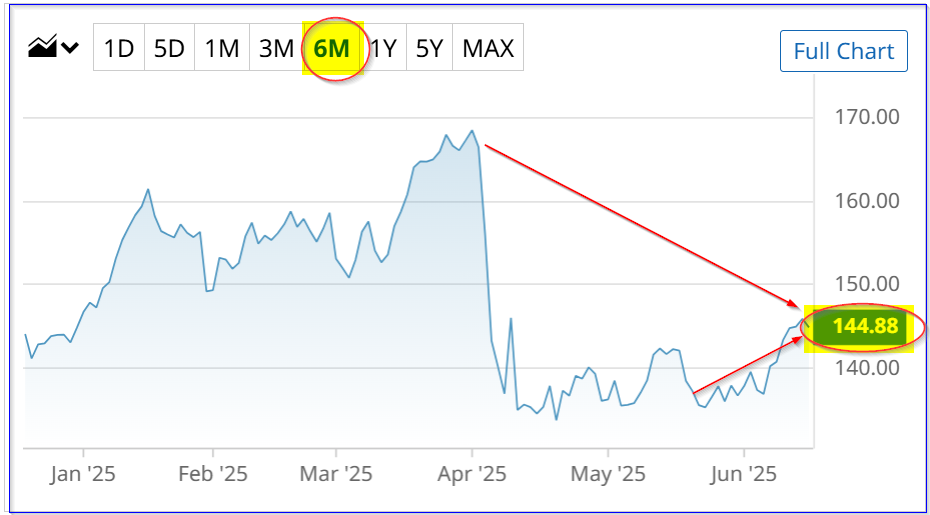
Chevron Corp (CVX) stock looks undervalued with its 4.73% dividend yield, compared to its 5-year average of 4.18%. Moreover, Chevron will raise the dividend in 2 quarters. That implies the price target for CVX is 15.8% higher at $167.46. This article will show why.
CVX is at $144.49 in midday trading on Monday, June 16. The dividend per share (DPS) is $1.71 per quarter, i.e., $6.84 annually, making its annualized yield equal to 4.73%.

Dividend Yield Price Target
Based on Morningstar's 5-year average of 4.18%, CVX stock could be worth much more. For example, let's divide $6.84 by the average yield:
$6.84 / 0.0418 = $163.64
That is $19.15 higher than today's price, implying an upside of 13.3% from here.
But that is not it. Chevron has consistently raised its DPS every year for the past 37 years, according to Seeking Alpha. Last year it raised the DPS by 4.9% and the prior year by +2.5%.
Moreover, Chevron has already paid out 2 quarterly dividends. So, let's assume that two more quarterly dividends over the next 12 months will be 3.8% higher, or $1.78 per share.
Therefore, the next four quarterly dividends may be:
$1.71+1.71+$1.78+$1.78 = $6.98
We can round the next 12 months (NTM) DPS to $7.00 per share for purposes of valuing CVC stock:
$7.00 / 0.0418 = $167.46 price target
That implies upside of +15.9%, almost 16% from today's price. This is a very simple way to set a price target for an investment in CVX stock.
However, there is no guarantee that an investor will make this return. Therefore, it's best to set a lower buy-in price. One way to do this is to sell short out-of-the-money (OTM) put options.
Shorting OTM Puts
I discussed this play in my last Barchart article on May 6. I recommended selling short the $130.00 strike price put option for the June 6 expiration period.
At the time, CVX was at $136.20, so the strike price put was 4.7% below the trading price. The short-put yield was 1.785% (i.e., $2.32 premium/$130 strike price) over that period of 31 days to expiry (DTE).
As it turned out, CVX closed at $140.21 on June 6. The put option remained out-of-the-money (OTM). The investor not only kept the 1.785% short-put yield, but also had no obligation to buy shares at $130.00.
This play is worth repeating. For example, look at the July 18 expiration period, 32 days to expiry (DTE).
It shows that the $135 put options strike price, 6.8% below today's price, has a midpoint premium of $1.05 per put contract. That means an investor can make a short-put yield of 0.78% (i.e., $1.05/$135.00 = 0.00777).

However, the $140 strike price shows a midpoint premium of $2.07, although this strike is only 3.3% out-of-the-money. It also has a much higher delta ratio of 31% compared to 16.7% for the lower strike price. That implies a higher chance of the stock falling to this point.
Nevertheless, the short-put yield is much more attractive at 1.48% (i.e., $2.07/$140.00).
This means an investor who does an even mixture of both these short-put plays can make an average one-month yield of 1.13% (i.e., (1.48% + 0.78%)/2).
That is a very high expected return (ER), as if it can be repeated each month, the annualized ER is 13.56%.
Downside Risks
If CVX falls to $135 or lower, the investor who had sold to open these put contracts, will have their account assigned to buy 100 shares of CVX per put sold short for $13,500. That is why brokerage firms require collateral, typically equal to 100 shares or $13,500.
That is not the end of the world. For one, the actual breakeven is lower than the strike price.
For example, after receiving the $1.00 in short-put income, the investor's breakeven point is:
$13,500 - $100 = $13,400, or $134.00 per put contract
That is 7.2% below today's trading price. That helps ameliorate any potential unrealized loss from shorting these puts.
Moreover, at this point, the investor will be earning a very good annualized next 12-month (NTM) yield:
$7.00 NTM DPS /$134.00 = 0.0522 = 5.22%
That implies upside of almost 25% based on the price target above:
$167.46 / $134.00 = 1.249 = +24.9%
The bottom line is that CVX stock looks cheap here. One way to play it is to set a lower buy-in price by shorting near-term out-of-the-money (OTM) put options.
On the date of publication, Mark R. Hake, CFA did not have (either directly or indirectly) positions in any of the securities mentioned in this article. All information and data in this article is solely for informational purposes. For more information please view the Barchart Disclosure Policy here.






